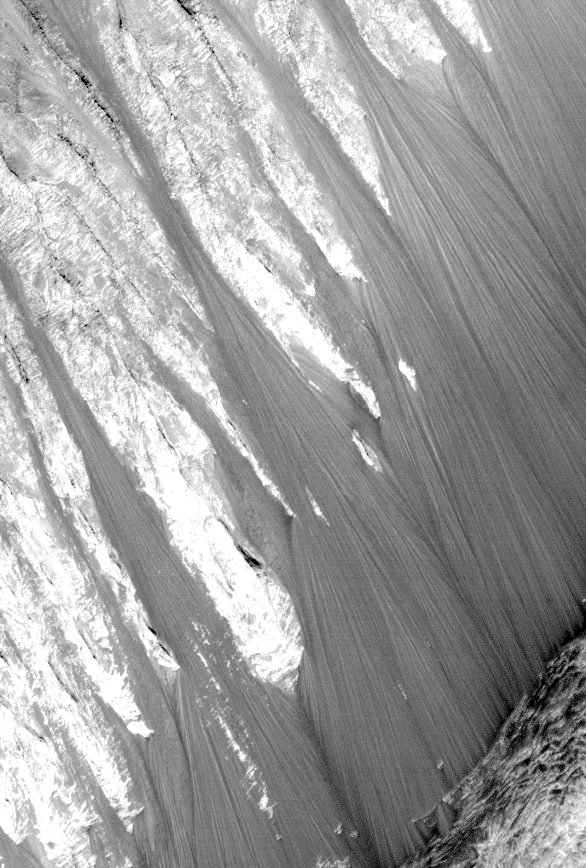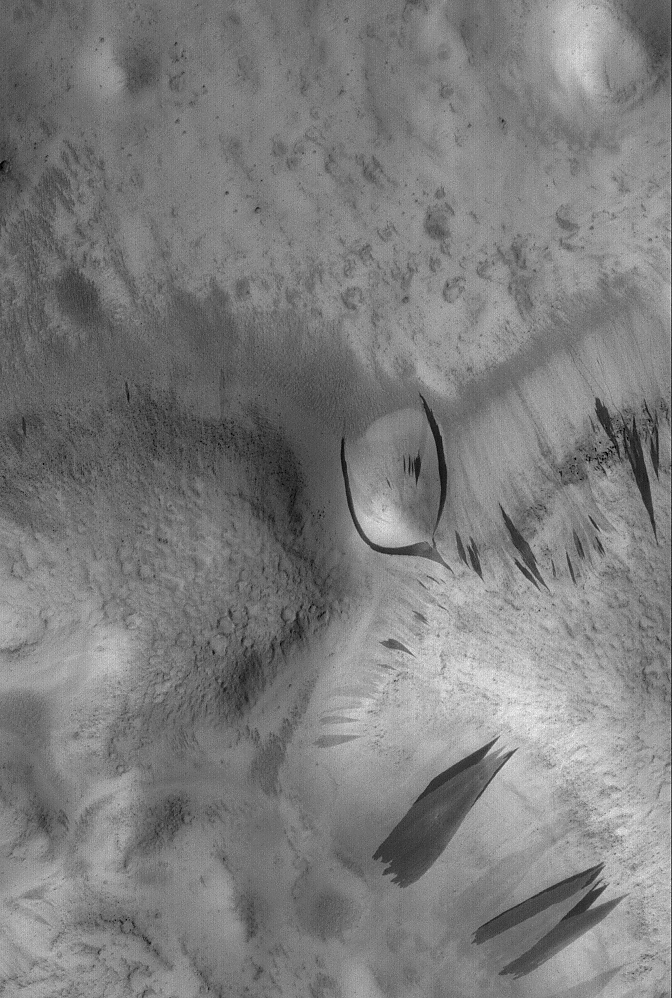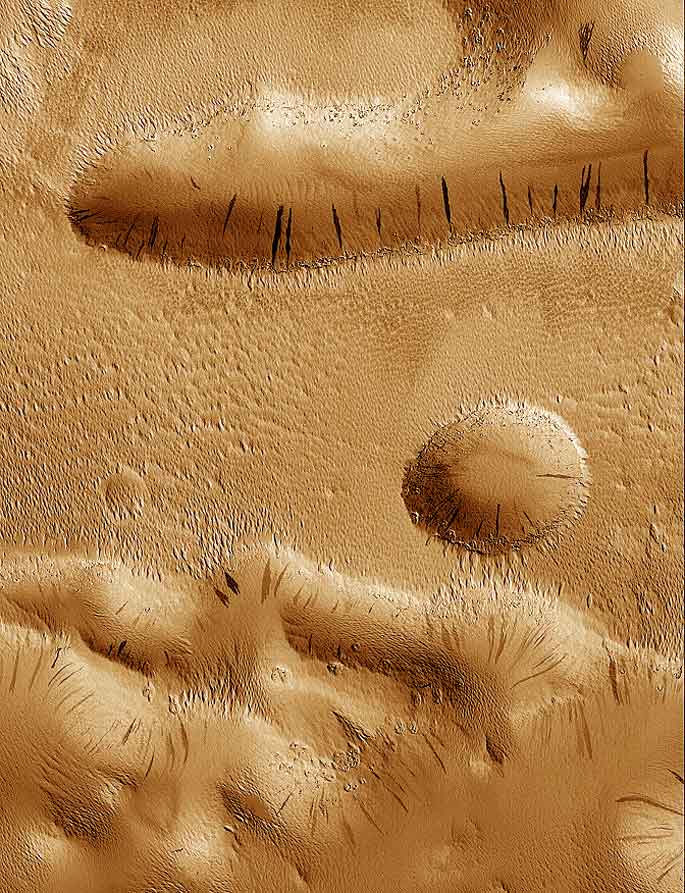|
The Enigmas on Mars |
||||
|
Is There Liquid Water on Mars? Part Two .
The Blue Bird Files
Water on Mars? Posted by blue bird on April 8, 2007 at 20:37 GMT (ID:3100265) Water on Mars? "Waterfall' in frozen state - as suggested on J. Skipper site (Mars Anomaly Research). It's amazing. He always give you link to the NASA image.
Editor's Note:
|
||||
| Posted by zorgon, on April 8, 2007 at
23:24 GMT (ID:3100715)
quote:
Originally posted by
Xtal_Phusion
LOL This time I have to agree that we are not looking at Vegetation... I am here on page one so forgiveme if someone pointed this out... But the OP showed us an image of the south polar CO˛ ice fields and the Malin page even says "thawing ice" Okay so what are the black thingies? Something truly alien and only found on Barsoom... As the sun warms the ice, the rays go through the ice and warm the black sand... then as the ice melts from the bottom up (sublimates directly to CO˛ gas...) the ice field levitates... actually floats above the surface... Yes you heard me LEVITATES... As holes appear the black sand is whooshed out the holes by the gas pressure making awesome geysers of black sand... All the details and close up images from Malin are here... http://www.thelivingmoon.com/43ancients/02files/Mars_Images_10a.html The Martian TREES are here :P http://www.thelivingmoon.com/43ancients/02files/Mars_Images_09.html Now lemme read the rest of the pages
in the thread
and see if anyone noticed this |
||||
| Posted by zorgon, on April 8, 2007 at
23:34 GMT (ID:3100728)
quote:
Originally posted by
Fiverz
Oy listen up a sec folkes! Though they do need water... trees and other vegetation take in CO˛ something which Mars has in abundance and GIVE OFF Oxygen Lets at least get our facts straight
on that issue |
||||
| Posted by zorgon, on April 9, 2007 at
00:12 GMT (ID:3100757)
quote:
Originally posted by
selfless
Yep it was mentioned once and ignored LOL Edited to Add...
I read all the thread and I see a
lot of bickering
over this.... but no one yet figured this out, even
thought its all over
the internet... (oh yeah you have to know where to
look Here is a picture of the Polar Ice
Cap... not hard
to find really...
But the black "trees" in this case
are GEYSERS of SAND
{for those who never follow links here is a
picture...}
Now stop bickering and look at those truly Alien geysers coming from levitating fields of Carbon Dioxide Ice... it doesn't get more Alien than this! Oh and check out the shadows they
leave in close up...
Oh yeah almost forgot... the stuff
on the craters edge
of the water lake in that crater.... ESA is saying
they think its snow |
||||
| Posted by laiguana, on April 9, 2007
at 01:41 GMT
(ID:3100815)
Well that nearly explains it all for
me. I had no idea
that these geysers were so abundant on Mars. Now
that you mentioned it
I can see how the majority of these 'anomalies',
viewed in these photographs,
fit the description. |
||||
| Posted by zorgon, on April 9, 2007 at
01:13 GMT (ID:3100868)
quote:
Originally posted by
mikesingh
HEY I missed that one!! Seems that thread got lost on the favorites list... see what happens when you jump all over the place? LOL That is as good as the "true color" River that John Lear posted...
|
||||
| Posted by blue bird, on April 9, 2007
at 06:03 GMT
(ID:3101098)
Thank's zorgon for nice picks! About geysers - and dark spots as a result, was imaged before by NASA, and they called them 'SEEPS' / Suspected Evidence of Erosion Process Sites/ but at that time call was that it is evidence of underground ice melting! Here is research paper with lots of
images; "Martian
Water
Stains or Dust Slides?"
Image Source: Malin Space
System - S1802576
(This is the original source image...) Color Image Source: Malin/Space.com - 20162-M1101809 Here are some more images from SPACE. COM: Mars Image Thread But these images of ELONGATED dark
spots are not the
same in appearance, - as those 'branching' images
that - reassembles 'trees'.
Original Image Source; Malin Space Systems - M0804688 Editors Note:
|
||||
| Posted by blue bird, on April 9, 2007
at 07:26 GMT
(ID:3101208)
quote:
Originally posted by
zorgon
"Giant Pool of Water Ice at Mars' South Pole" Excerpt
"Mars is unlikely to sport beachfront property anytime soon, but the planet has enough water ice at its south pole to blanket the entire planet in more than 30 feet of water if everything thawed out. With a radar technique, astronomers have penetrated for the first time about 2.5 miles (nearly four kilometers) beneath the south pole’s frozen surface. The data showed that nearly pure water ice lies beneath. “This is the first time that a ground-penetrating system has ever been used on Mars,” said the new radar study’s lead author, Jeffrey Plaut of NASA’s Jet Propulsion Laboratory. The reflected beams revealed that 90 percent or more of the frozen polar material is PURE WATER ICE, sprinkled with dust particles. The scientists calculated that the water would form a 36-foot-deep ocean of sorts if spread over the Martian globe......." SOURCE and rest of article: (On File) So - for a long time it is no secret to scientists that Marth south pole - conteins CO2 ice, BUT >>> "Measurements in recent years found strong evidence for abundant WATER ICE BENEATH, and that it gets exposed during summer melts of the overlying carbon dioxide." Bluebird
PEGASUS ADDITION Mars Mystery: Strange Spirals in Ice Caps Explained Excerpt
"Odd spiraling gorges etched deep into the polar ice caps of Mars have stumped scientists for decades. The huge arcing troughs radiate outward like arms of a pinwheel, creating an overall shape that visually and mathematically resembles hurricanes, spiral galaxies and even some seashells. Now there is an apparent solution to the mystery, put forth by Jon Pelletier of the University of Arizona in Tucson. The tilted planet causes ice on one side of a crack to heat and vaporize, deepening and widening the crack. Then the water vapor hits the shady, colder side of the growing canyon and refreezes. Eventually, chasms more than a half-mile (1 kilometer) deep developed, and they cover hundreds of miles of the polar regions. But only on Mars, it seems..." SOURCE
and
rest of article: (On File)
|
||||
| Posted by zorgon, on April 9, 2007 at
10:04 GMT (ID:310148)
Yes but C02 ice thaws at -109.3 °F or -78.5 °C so its going to need to get a lot warmer on Mars before that water ice will be ready for taking a dip... And I don't buy the 36 feet of water over the entire planet if the pole melts... As ice expands when it freezes I just don't see the quantity of ice at the poles to cover that much.. Some here have talked about the scarcity of water in the solar system... we know there are electric storms on all the planets... if you have ANY oxygen and hydrogen in the air sooner or later the result will be water molecules so I would hazard a guess that water exists in a lot more places than most expect... |
||||
| Posted by blue bird, on April 10,
2007 at 04:48 GMT
(ID:3103636)
I am not 100% sure either in 'raw' images not to edited by NASA - for example, you have right and left camera on rover, both of them are one unit and should have the same angles when shooting, and than you have - one with sky and other without...not to mention colors Speaking of 'dry' Mars. does this
look dry or rather
pretty muddy and wet:
Posted by blue bird, on April 11, 2007 at 16:36 GMT (ID:3107720) quote:
Originally posted by
SuicideVirus
TEMPARATURE
And that for example Viking measured
warmest soil occasionally
reaches +81° F (27° C).
DRY !? Do you find this soil dry or muddy and wet? (referring to image above)
PEGASUS ADDITION Salt on Mars - Indication of Former Sea Beds It also appears in many Rover tracks that the ground may indeed be moist, as the salt will appear after a few minutes as if the exposed salt was drying. More on this to follow... SOURCE: Pegasus Files 'Salty Soil" (On File) Mars Rovers Explore Hints of Salty Water Excerpt
NASA's Opportunity rover sent back new images from Mars showing that small spheres previously found on the surface also exist below, in a trench the rover dug. Hints of salty water were also found in the trench, but much more analysis is needed to learn the true composition. Meanwhile Opportunity's twin rover, Spirit, is about to dig a trench of its own in order to investigate soil that sticks to its wheels, suggesting the fine-grained material might be moist. In a press conference today, officials said the soil at both locations could contain small amounts of water mixed with salt in a brine that can exist in liquid form at very low temperatures. The scientists stressed that only miniscule amounts of water would be needed to create the brine. Water is the main thing scientists are searching for at Mars, because all life as we know it requires liquid water. SOURCE: Space.com (On File) Water Once Filled Mars Opportunity Rover Landing Site Excerpt
"The landing site of the Mars rover Opportunity was once drenched with water, providing an environment that could have supported life, NASA scientists announced at a press conference today. Water once covered or infused the small crater in which the rover sits, then it gradually evaporated away leaving high concentrations of salt behind. A lake or ocean at the site and beyond might have once been the size of one of Earth's Great Lakes. Or the area might have been loaded with groundwater that rarely if ever reached the surface. And while no signs of biological activity are likely to be uncovered by the current mission, scientists are ecstatic that they now know exactly where to look for past life on Mars..." SOURCE and rest of article: (On File) Mars Rover Sits on Ancient Beach Excerpt
The US space agency has announced that its robotic Mars rover Opportunity is parked on what was once the shore of a salty Martian sea. There is multiple evidence that the surface of Mars was awash with liquid water at some time in its past. But the latest findings from Nasa's robot explorers on the Red Planet are fleshing out a picture of what Mars must have been like when it was wet... "If you have
an interest in searching
for fossils on Mars, this is the first place you
want to go
SOURCE: BBC and rest of article: (On File) Water on Mars? Flood of Data, Trickle of Answers Excerpt
Both rovers recently dug trenches that revealed clumpy material that might involve very small amounts of water vapor from the atmosphere combining with salt in the soil to form a sticky brine. A full analysis of the trench data -- gathered by multiple instruments -- is underway. Most scientists are convinced Mars was once warmer and wetter. The questions nowadays involve where the water was, where it went, and whether it was around long enough to foster life. |
||||
|
.
Flyover from the submerged northeast Hellas Planitia to the Hesperia Planum. |
||||
| FAIR USE NOTICE: This page contains copyrighted material the use of which has not been specifically authorized by the copyright owner. Pegasus Research Consortium distributes this material without profit to those who have expressed a prior interest in receiving the included information for research and educational purposes. We believe this constitutes a fair use of any such copyrighted material as provided for in 17 U.S.C § 107. If you wish to use copyrighted material from this site for purposes of your own that go beyond fair use, you must obtain permission from the copyright owner. | ||||
|
|












